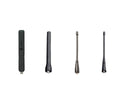
Different Types of Antennas for Two-Way Radios
, by Joseph Gabriel, 2 min reading time

, by Joseph Gabriel, 2 min reading time

Two-way radios are designed to receive and transmit radio waves across vast distances. The antennas determine the quality and distance of two-way radio transmissions. That’s why it’s immensely important to choose the right one for efficient and clear contact. Keep reading to learn about the different types of antennas for two-way radios and which one will maximize your business’s communication.
VHF and UHF are two acronyms you’ll see frequently in reference to radio frequencies, two-way radios, and antennas.
VHF stands for Very High Frequency. The radio frequency is between 30 to 300 megahertz (MHz). UHF, or Ultra High Frequency, ranges from 300 MHz to 3 gigahertz (GHz).
VHF functions more efficiently with clear lines of sight and very few obstructions. UHF signals are more efficient at communicating radio waves around buildings, wooded areas, and more.
Now, let’s learn about the different types of antennas! If you need a handheld two-way radio, there are two antenna options to pick from: stubby or whip. They’re both available in either VHF or UHF signals.
A stubby antenna ranges from two to four inches long. Most frequencies begin at 160 MHz to upward of 450 MHz. Substantial distance isn’t achievable with stubby antennas since the antenna is quite small. Nevertheless, it’s a favorable compact handheld option.
Whip antennas are the more desirable choice for considerable range. They are between seven and eight inches, so they can get in the way while moving around an office or construction site. However, this handheld antenna option will provide enhanced and reliable communication for employees across a greater distance.
Sometimes, handheld antennas aren’t enough. If the transmission appears weak or doesn’t achieve the distance you require, a base station antenna is the strongest option for contact. Transmissions from portable devices route though the base station, which can transmit at a higher frequency.
Two-way radios for business will benefit from a base station for enhanced communication. Choose the antenna based on its frequency capabilities so it can properly send radio waves to each portable device. When it comes to finding the right location for the antenna, remember that the higher the antenna sits, the better the connection will be.